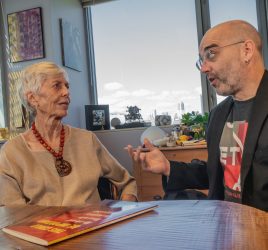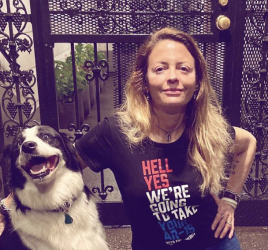How We May Read #1
A few months back, I began writing up my thoughts and research regarding reading and interactive environments over at Jane Friedman’s blog.
I promise very soon Jane that I will return to that endeavor. There’s more to say and my research has been parsed now. Until then, I’m re-posting my work.
I.
In August 2010, I sat down with my friend and colleague Prof. Jennifer George-Palilonis, the head of the graphics sequence at Ball State University’s Department of Journalism, and asked her if she’d collaborate with me on a book project.
However, this wasn’t just a simple book project. This year long project, dubbed Transmedia Indiana, would have multiple layers:
- We would gather a group of 40-50 students from different majors (journalism, creative writing, public relations, history, theater) to plan, build, finish, and launch the book;
- The book would be something more than just an interactive, multi-media story — it would extend outside its digital pages and leak into the real world — but the actual book itself would only exist on tablets and eReaders; and
- This book would use real life artifacts from the Indiana State Museum in a manner similar to the book The DaVinci Code or the movie National Treasure.
For some, Transmedia Indiana may sound more like a game than a book. Others may see it nothing more than a glorified multimedia story.
For us, we saw this as a grand opportunity to study and learn how we may soon read and examine what that means for authors in the tablet age. Since the book would require readers to interact with our content and (possibly) the real world, we thought it might be interesting to study not only how people read within an interactive environment, but also how people are motivated to act in virtual and real spaces.
That was the real fun.
II.
The first time I heard the word transmedia was in early 2005. I had just taken a job at MIT’s Technology Review, the nations oldest technology magazine. I was in charge of creating its online operation, which meant amongst other elements I needed a plan to build out the editorial operation. One writer we had access to was Dr. Henry Jenkins, the man who founded the universitys Comparative Media Studies program. I’d met Henry in 2002 when John Borland and I were working on Dungeons & Dreamers, a book about game culture, and I was excited about the possibility of having his work on my site.
We went to lunch in Cambridge, Massachusetts, to discuss his interests. He was working on a book about the convergence of media, he told me, and he wanted to explore some of that at Technology Review.
I agreed to his terms as soon as I possibly could. When I returned to work that day, I e-mailed John to tell him that I knew my days in journalism were coming to an end. This transmedia storytelling sounded way too interesting.
III.
The tablet and eReader environment create an interesting paradox for writers.
Dale Sheppard (2011) found that while students were more engaged in texts delivered in an interactive environment, they didn’t necessarily learn more. In fact, some became more passive as they anticipated the device delivering information, thus reducing the likelihood the human would be proactive in terms of information gathering.
That disturbing thought is offset by the reality that digital reading environments offer the potential to create complex, interconnected relationships that are easily navigate-able by readers, allowing us to reconceptualize what the experience of reading may look like (Kostic 2011). And we are starting to get a sense of what readers expect within this environment: searchability, access to companion information alongside the primary information, and shareability. (Lam 2009)
The interactivity engages readers, although it’s unclear how much they take away from the experience because of selective attention. Yet this device creates a framework for which we might tell increasingly complicated and networked stories.
The problem for authors (or writers? or storytellers?) is that nobody is quite sure what tools to use to tell stories within this environment, and there are no ubiquitous tools like WordPress that enable building stories within that environment.
As an academic and a writer, that means it’s time to research and prototype so we can develop the skills — and the tools — to tell rich stories that resonate with readers.
IV.
Ask the wrong person to define transmedia storytelling and you’ll end up on the business end of a rant. Jenkins (2006) initially defined the term loosely as a story that takes place either across multiple delivery mediums or as a story world in which multiple stories take place (e.g. Star Wars and its companion comic books, games, books, ect.) For many, his second definition — which sounds more like an entertainment franchise and less like a story — became his de facto position on the subject.
Brooke Thompson (2010) built upon that definition, focusing her efforts on the interactive elements within a story. Multiple media stories are those with no interaction (e.g. a story with a picture and video that sit separate); cross-media stories are those with one-way or limited interaction (e.g. you read a story, then click a video, then listen to audio); transmedia stories are those with complex, spider-web-like interactions that encourage exploration across mediums.
Jenkins, Thompson, and countless others are helping the framework to tell these stories even if we haven’t quite yet figured out how those stories will “look” and “feel” within the tablet and eReader environment.
V.
Whats missing is something beyond frameworks, software tools, and storytelling. We’re missing pleasure, which is part of a strand of research called Human Factors that blends traditional usability (e.g. how many seconds does it take you to click that button?) with psychology, cognitive science, and pleasure in order to understand how the people within a system affect that system.
For instance: There is an “ideo-pleasure” associated with purchasing environmentally sound products that may override a device that is less functional or that costs more. Our pleasure centers impact our relationship with the objects we use.
In the case of reading printed books, there is a “social pleasure” associated with pulling out your favorite novel on the subway. People can see you reading, and the book says something to those around you about the kind of person you are in a very general way. Remove that social pleasure, and the act of reading is changed. (I’ll address the pleasure people often express with books — “but I just love the feel of the paper” — in a few weeks.)
This tablet-based environment removes some of that particular social pleasure. Whats in its place? We don’t yet know. Maybe transmedia narratives will create an agency within real space that replicates that type of “social pleasure” that has been lost. Or maybe authors who understand how to create that within a tablet-based environment will have a leg up on those who don’t.
VI.
Were nearly 3 months into our Transmedia Indiana project, and were about to launch our first research study as we try to suss out what makes a good reading experience within the interactive, tablet environment.
I’ve also launched a companion project, a two-year research study, in which Ill be building personas of readers by crunching data taken from surveys and interviews in order to better understand how, where, and why we read. (That’s my not to subtle pitch for you to take my survey and pass it along to your friends!)
Along the way, Jenn and I will be prototyping, testing, and writing about our research both in peer-reviewed journals and in places like Janes blog, where we can bridge the gap between research and the real world.
Expect dispatches from me two Mondays each month (mostly), and feel free to follow my research at my teaching site or my informal writing about my work on my personal site.
Works Cited
Jenkins, H. 2006. Convergence culture: Where old and new media collide. NYU Press.
Jordan, P.W. 1998. “Human factors for pleasure in product use.” Applied ergonomics 29 (1): 2533.
Kostick, A. 2011. “The Digital Reading Experience: Learning from Interaction Design and UX-Usability Experts.” Publishing Research Quarterly 27 (2) (June): 135-140.
Lam, P., S.L. Lam, J. Lam, and C. McNaught. 2009. “Usability and usefulness of eBooks on PPCs: How students opinions vary over time.” Australasian Journal of Educational Technology 25 (1): 3044.
Sheppard, D. 2011. “Reading with iPads–the difference makes a difference.” Education Today (11) (August): 12-15.
Thompson, Brooke. 2010. Towards a definition of transmedia…: Brooke Thompson: GiantMice.com. Giant Mice. April 16. http://www.giantmice.com/archives/2010/04/towards-a-definition-of-transmedia/.



